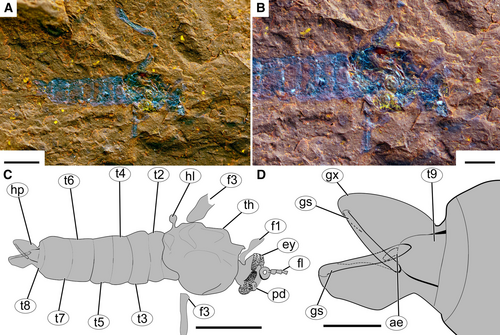Describen nuevas especies de insectos acuáticos que habitaban en las selvas prehistóricas de Australia

Imagen de una larva de Slidaea fosilizada encontrada en McGrath Flat // Viktor Baranov
Un equipo científico liderado por la Estación Biológica de Doñana – CSIC ha descrito por primera vez una nueva especie y varios morfotipos de insectos acuáticos de la época del Mioceno a partir de los fósiles encontrados en el yacimiento McGraths Flats, descubierto en 2022 en la región de Nueva Gales del Sur, Australia. En el estudio, publicado en la revista científica Papers in Palaeontology, ha participado también personal científico del Australian Museum Research Institute y la Universidad de Canberra.
Los resultados de este estudio ofrecen nuevos datos sobre los cambios a largo plazo que han experimentado el clima y la biodiversidad australiana. Hoy gran parte de Australia es árida, con grandes extensiones de desierto y pastizales, pero antes del Mioceno, hace entre 16 y 11 millones de años, la región estaba poblada de selvas y bosques tropicales. Hoy, debido a cambios en la temperatura y las precipitaciones, estos ambientes más húmedos sólo existen en pequeñas áreas al norte del continente, próximas a la costa. “La falta de fósiles bien preservados, sin embargo, había dificultado hasta ahora el estudio del clima y la biodiversidad de Australia”, explica Viktor Baranov, investigador de la Estación Biológica de Doñana – CSIC y primer autor del estudio.
Fue en 2022 cuando un equipo científico, liderado por el Dr. Matthew R. McCurry, conservador de Paleontología del Australian Museum y entre los que se encontraba Baranov y otras personas, reveló un descubrimiento extraordinario. Incluso llegó a ser señalado por la revista National Geographic como uno de los descubrimientos científicos más increíbles del año. En el centro de Nueva Gales del Sur, una región situada al este de Australia, Nigel McGrath encontró en sus tierras una gran variedad de singulares rocas. En ellas se observaban, como impresas, espectaculares fósiles de organismos. Tras diversas excavaciones, el equipo científico confirmó que se hallaba ante uno de los yacimientos de fósiles más espectaculares del mundo, al que denominaron McGrath Flat. Sus fósiles conservaban de manera excepcional una rica diversidad de plantas, insectos, arañas y vertebrados. Este descubrimiento permitía a la comunidad científica adentrarse en el estudio de las especies que habitaban la región antes de que las reducidas lluvias del Mioceno hicieran que sus selvas desaparecieran.
Chaoborus abundans revela cómo pudo tener lugar el proceso de fosilización
El estudio que acaban de publicar es el resultado del trabajo de campo que Viktor Baranov, actual investigador de la Estación Biológica de Doñana – CSIC, realizó en 2020 en la zona con el apoyo del Australian Museum Research Institute. El equipo científico ha identificado una nueva especie de Chaoboridae o “mosquitos fantasma”, al que han denominado Chaoborus abundans por su gran abundancia, con representaciones de millones de larvas y pupas en todo el yacimiento. Así mismo, se han descrito varios morfotipos de otros grupos, que, aunque no ha sido posible describirlos a nivel de especie, sí que no parecen encajar en ningún otro grupo descrito con anterioridad. Se han hallado tres nuevos morfotipos de la familia Chironominadae, uno de Limoniidae y otro de Sialidae.

Nivel de detalle de este adulto macho de Chaoborus abundans // Viktor Baranov
Además de los resultados taxonómicos, los fósiles también han arrojado algunas claves sobre la ecología de estas especies, especialmente sobre el género Chaoborus, cuya abundancia ha posibilitado un análisis detallado de su morfología y su desarrollo (ontogenia), así como del paisaje prehistórico del yacimiento. “Las cuatro fases larvarias de la especie estaban presente en los registros fósiles, lo que indica que los fósiles fueron depositados in-situ y no fueron trasladados por el agua desde otro lugar”, explica Baranov. “Esto es importante, porque las especies del género Chaoborus tienen unas preferencias ecológicas muy bien definidas. Sus larvas tienden a vivir en cuerpos de agua estáticos con pocos o ningún pez, lo cual sugiere que el proceso de fosilización de McGrath Flat pudo haber tenido lugar en un lago pequeño o en el brazo de muerto de un río.”
McGrath Flat, una ventana al pasado y al futuro
Los fósiles de McGrath Flat se están convirtiendo en una ventana inigualable para el estudio del Óptimo Climático del Mioceno Medio, un periodo cálido y húmero de la historia de la Tierra que precedió a un gradual enfriamiento y una reducción de las precipitaciones. Desde entonces, el clima australiano se ha vuelto cada vez más seco, pero desde hace relativamente poco, a un ritmo mucho mayor debido al cambio climático. Con el estudio de este yacimiento, la comunidad científica podrá profundizar en el impacto de la aridificación de los ecosistemas naturales a lo largo de grandes periodos de tiempo, una tarea que es crucial para entender los cambios futuros que se producirán en el medioambiente.
“España en particular, está sufriendo procesos de aridificación en muchas áreas. En estas condiciones, observar cómo ha cambiado el medioambiente en el pasado es una de las mejores herramientas para estimar hacia donde se está dirigiendo nuestro propio medioambiente y cómo tendremos que adaptarnos en el futuro”, señala Baranov. “Los fósiles de McGrath Flat son más que simples vestigios del pasado, son un canario en la mina, que nos avisa de cómo bosques frondosos pueden transformarse en praderas semidesérticas. Esperemos que, al tener más información sobre los efectos a largo plazo de la aridificación, podamos estar más preparados para afrontar sus consecuencias”.
Referencias
Viktor Baranov, Michael Frese, Robert Beattie, Tara Djokic, Matthew R. McCurry. New aquatic insects form the Miocene of Australia with notes on the ecology and ontogeny of a new species of Chaoborus (Diptera, Chaoboridae). Papers in Palaeontology. https://doi.org/10.1002/spp2.1580
Matthew R. McCurry, David J. Cantrill, Patrick M. Smith, Robert Beattie, Mary Dettman, Viktor Baranov, Charles Magee, Jacqueline M. T. Nguyen, Marnie A. Forster, Jack Hinde, Ross Pogson, Helen Wang, Christopher E. Marjo, Paulo Vasconcelos, Michael Frese. A Lagerstätte from Australia provides insight into the nature of Miocene mesic ecosystems. Science Advances. https://doi.org/10.1126%2Fsciadv.abm1406